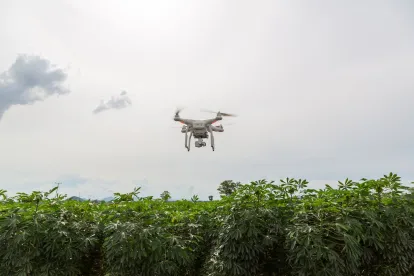Drones, or unmanned aerial vehicles (UAVs), are experiencing rapid growth throughout the world. In the United States, the FAA expects the recreational UAV fleet to reach almost 1.5 million units by 2024. Significant growth is also expected in commercial drones used for safety, delivery, and service operations, with the number of such aircraft expected to approximately double in the next year. UAVs will bring innovations across a variety of sectors, including critical infrastructure, public safety, agriculture, and delivery of consumer goods and services.
In January, the Federal Communications Commission (FCC) released a Notice of Proposed Rulemaking seeking to modernize its spectrum rules to support the growth of UAV operations. The rulemaking touches on a number of important issues regarding UAV spectrum. In particular, the proceeding highlights a little-known licensing compliance issue relevant to UAV operators.
Current VHF Radio Licensing for UAV Operators
The aeronautical VHF band (117.975 MHz -137 MHz) is used by aviation for air traffic control (ATC) and advisory communications, among other aviation-safety purposes. The FCC’s rules have long recognized the use of this band for manned flights. In fact, Section 87.18 of the FCC’s rules provides that pilots of domestic manned flights are generally automatically granted licenses for VHF aircraft radios without the need to apply to the FCC. However, the FCC’s rules require that such radio equipment be “located on board an aircraft,” which presents an obvious problem for UAV operators, which usually seek to communicate using ground-based radios.
One way that UAV operators have addressed this issue is by use of an “ATC Relay.” An ATC Relay involves an operator communicating with a UAV via an alternate channel, which is converted onboard the UAV into an aeronautical VHF channel for communication with ATC or other aircraft. Because the VHF radio is onboard the UAV, its use is consistent with the FCC’s rules. However, according to the FCC, such relay systems are still relatively nascent.
Instead, operators more commonly rely on ground-based “aircraft” radios without the use of a relay radio on the UAV. Although such stations are not authorized under the FCC’s rules, the Commission has addressed this discrepancy through the “Special Temporary Authorization” (STA) process. STAs are valid for up to 180 days (renewal is possible) and permit the pilot in command, or other personnel on the ground, to directly communicate with ATC or other aircraft via ground-based radios as though the radio were present on an aircraft. The STA application process is relatively straightforward, though the FCC does typically require a copy of the UAV operator’s Certificate of Authorization (COA) from the FAA.
A Path Forward
Clearly, case-by-case temporary authorizations for UAV communications are not ideal, given the explosive growth in the market. A better solution would be for the FCC to conform its rules to the real world. To its credit, the FCC is poised to do just that. In its Notice of Proposed Rulemaking, the FCC proposes to individually license VHF ground stations under a new category known as “Unmanned Aircraft Operator VHF Ground Station.” This type of authorization would require applicants to submit a Form 605 requesting license authority. The FCC proposes to require endorsement from the FAA, most likely in the form of a COA. Once issued, the license would authorize ground-based communications for UAV flights on all air traffic control, flight service station, aeronautical advisory station (unicom), and aeronautical multicom station channels authorized for use by aircraft. The FCC believes this process will mitigate concerns regarding the oversaturation of critical aeronautical channels as drone use grows.
Conclusion
The FCC has not announced when a final rule will be issued, although it is not uncommon for rulemaking proceedings to take a year or more. In the interim, UAV operators will want to ensure they comply with the FCC’s rules, including by securing special temporary authorization if necessary, for any ground-based use of aircraft radios.




 />i
/>i

